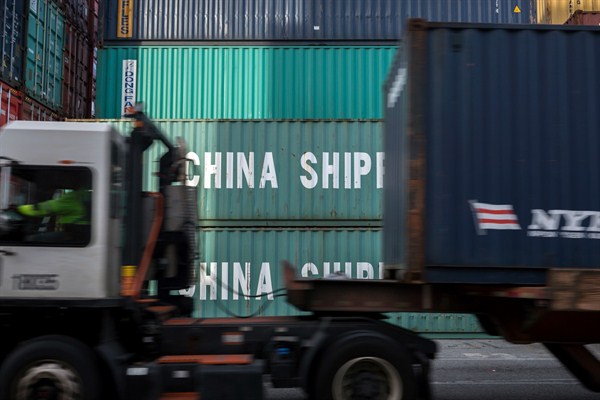President Donald Trump’s trade war with China escalated Tuesday, when he slapped tariffs on an additional $200 billion worth of Chinese imports. Beijing retaliated immediately with tariffs on an additional $60 billion worth of imports from the U.S. The move followed a similar round of tit-for-tat tariffs in July, when both sides targeted $50 billion worth of each other’s exports.
Trump famously declared on Twitter in March that trade wars are “good, and easy to win.” His optimism in the standoff with Beijing stems in part from the current strength of the U.S. economy, the more-troubling recent economic indicators for China, and the fact that the bilateral trade imbalance—China exports $506 billion worth of goods to the U.S., compared to just $130 billion in U.S. exports to China—gives the U.S. far more targets for applying punitive tariffs. Analysts are less sanguine, arguing that China can find other ways to penalize American imports and investments, and that ultimately the U.S. consumer—and the global economy—will foot the bill for Trump’s tariffs.
But China isn’t the only target of Trump’s trade wars. He has also slapped tariffs on steel and aluminum imports from the European Union and NAFTA partners Mexico and Canada, among others, while using threats of yet more tariffs—particularly on cars—in an effort to gain concessions in ongoing negotiations with the EU and talks to update NAFTA. This collection of five recent WPR articles offers comprehensive analysis and context to understand this headline news.
The Three Big Things Trump Doesn’t Get About Trade Policy
Kimberly Ann Elliott | June 19, 2018
Trying to follow trade policy under the Trump administration makes your head spin, because a lot can happen between Donald Trump’s latest Twitter blast and the formulation of U.S. policy. As background to the many specific issues that arise on a seemingly daily basis, it is useful to clarify three fundamental realities about trade policy that Trump doesn’t seem to get. First, trade policy cannot, except at a very high cost, undo broad, macroeconomic forces that determine growth, job creation and trade balances. Second, following from that, trade policy is primarily redistributive in its effects. And third, trade policy is a lot more complicated today because modern supply chains are globally fragmented.
As a U.S.-China Trade War Looms, Are Trump and His Trade Hawks Winning?
Kimberly Ann Elliott | April 9, 2018
In April, after a relatively quiet first year in the White House, President Donald Trump began delivering on his campaign promises to get tough on trade, especially with China. In the short run, the economic effects of Trump’s moves are likely to be relatively modest. If Trump’s actions trigger retaliatory trade wars, however, the costs could escalate quickly. And if the Trump administration blatantly ignores the rules of the World Trade Organization in imposing sanctions over China’s industrial policies, it could fatally undermine the WTO’s viability. Overall, the long-term effects could include more global friction and less trade, with slower growth and lower incomes in the U.S. and around the world.
Trump’s Hard-Line Approach to Trade Talks Is No Way to Strike a Deal
Susan Ariel Aaronson | Feb. 5, 2018
In making trade policy, process is as important as substance. If the process is perceived as fair, the participants, both citizens and policymakers, will likely view the outcomes as fair. The Trump administration has never understood that. It demands “fairness” from its trade partners but doesn’t always treat them fairly. After immediately withdrawing from the 12-nation Trans-Pacific Partnership and threatening to withdraw from longstanding trade agreements, such as NAFTA and even the World Trade Organization, President Donald Trump has made it clear he views trade as a zero-sum game where only one side can “win.” But trade is about mutual benefit.
Trump’s Truce With the EU Offers Some Good News on Trade, for a Change
Kimberly Ann Elliott | July 31, 2018
While recognizing that it could be undone at any time by a single presidential tweet, there appears to be a truce on at least one front in Donald Trump’s trade war. During a July visit to the White House, European Commission President Jean-Claude Juncker pledged along with Trump to refrain from further escalation of the trans-Atlantic trade dispute and try to work things out. Their joint statement was vague, and the U.S. steel and aluminum tariffs on the European Union, and the EU’s retaliatory tariffs, remain in place. The good news is that the agreement seems to head off, for now, the imposition of new retaliatory tariffs between the U.S. and the EU.
While Trump’s Trade War With China Escalates, Don’t Forget About Cars
Kimberly Ann Elliott | Sept. 18, 2018
Despite hopes that the negotiations to salvage the North American Free Trade Agreement will conclude with some degree of success, the other fronts in U.S. President Donald Trump’s trade wars continue to escalate. The just-imposed tariffs on another $200 billion in U.S. imports from China will carry high costs for American consumers and exporters, much higher than the first round of tit-for-tat tariffs on $50 billion in trade with China this summer. Yet it is the political and institutional implications of potential tariffs on $200 billion in automobile imports later this year that raise even bigger questions.
The contents of this report, and of all In Context reports, can be viewed by both subscribers and non-subscribers. But only subscribers can access the full articles when they click through on the headlines above.
[marketing]boilerplate[/marketing]

